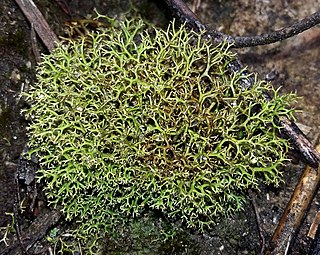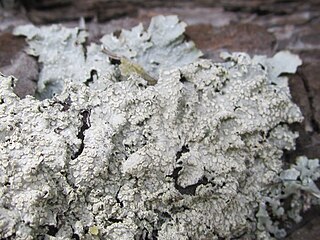
Cladia is a genus of lichenized fungi in the family Cladoniaceae. Cladia species have a crustose primary thallus and a fruticose, secondary thallus, often referred to as pseudopodetium. The type species of the genus, Cladia aggregata, is widely distributed, occurring from South America, South Africa, Australasia and South-East Asia to southern Japan and India. Most of the other species are found in the Southern Hemisphere.

Anisomeridium is a genus of lichens in the family Monoblastiaceae. The type species was originally named Arthopyrenia xylogena by Swiss botanist Johannes Müller Argoviensis in 1883; in 1928, Maurice Choisy defined the genus Anisomeridium, designating A. xylogena the type species.

Punctelia is a genus of foliose lichens belonging to the large family Parmeliaceae. The genus, which contains about 50 species, was segregated from genus Parmelia in 1982. Characteristics that define Punctelia include the presence of hook-like to thread-like conidia, simple rhizines, and point-like pseudocyphellae. It is this last feature that is alluded to in the vernacular names speckled shield lichens or speckleback lichens.
Japewiella is a genus of lichen in the family Lecanoraceae. It was circumscribed in 2000 by German botanist and lichenologist Christian Printzen as a segregate of the genus Japewia. The genus name of Japewia was in honour of Peter Wilfrid James, who was an English botanist. The genus was circumscribed by Christian Printzen in Bryologist vol.102 on page 715 in 1999.

Rhizocarpon is a genus of crustose, saxicolous, lecideoid lichens in the family Rhizocarpaceae. The genus is common in arctic-alpine environments, but also occurs throughout temperate, subtropical, and even tropical regions. They are commonly known as map lichens because of the prothallus forming border-like bands between colonies in some species, like the common map lichen.
Megalaria is a genus of lichen-forming fungi in the family Ramalinaceae. The genus was circumscribed by Austrian lichenologist Josef Hafellner in 1984, with Megalaria grossa assigned as the type species.

Notoparmelia is a genus of foliose lichens in the family Parmeliaceae. It includes 18 species that grow on bark and rocks, and are mostly distributed in the Southern Hemisphere. The genus was created in 2014 as a segregate of Parmelia.

Hertelidea is a genus of crustose lichens in the family Stereocaulaceae. Characteristics of the genus include carbon-black ring or outer margin (exciple) around the fruit body disc (apothecium), eight-spored, Micarea-type asci and mostly simple, hyaline ascospores that lack a transparent outer layer. Hertelidea species mostly grow on wood, although less frequently they are found on bark or soil. While the type species, Hertelidea botryosa, has a widespread distribution, most of the other species are found only in Australia.
Gintaras Kantvilas is an Australian lichenologist, who earned his Ph.D in 1985 from the University of Tasmania with a thesis entitled Studies on Tasmanian rainforest lichens. He has authored over 432 species names, and 167 genera in the field of mycology.
Amandinea devilliersiana is a species of crustose lichen in the family Caliciaceae, and found in South Australia. It was first described in 2013 by Australian lichenologists Jack Elix and Gintaras Kantvilas from a specimen collected on a granite boulder near the seashore in South Australia. The species epithet, devilliersiana, honours Brigitte de Villiers. Specimens used for the description came from both Tasmania and South Australia.
Punctelia transtasmanica is a species of foliose lichen in the family Parmeliaceae. It is found in Australasia.
Punctelia ulophylla is a species of foliose lichen in the family Parmeliaceae. It is found in Europe, where it grows on the bark of a variety of trees.
Punctelia subalbicans is a species of foliose lichen in the family Parmeliaceae. It is found in Australia and New Zealand, where it grows on the bark of various tree species.

Constipatic acid is a fatty acid found in several lichen species. It was isolated, identified, and named by Douglas Chester and John Alan Elix in a 1979 publication. The compound was extracted from the Australian leafy lichen called Xanthoparmelia constipata, which was collected on schist boulders west of Springton, South Australia. The related compounds protoconstipatic acid and dehydroconstipatic acid were also reported concurrently. Syo Kurokawa and Rex Filson had previously detected the compounds using thin-layer chromatography when they formally described the lichen as a new species in 1975, but had not characterised them chemically.

Punctelia perreticulata is a widely distributed species of foliose lichen in the family Parmeliaceae. It occurs in Mediterranean Europe and Russia, North America, South America, Australia, and New Zealand, where it grows on rocks, bark, or wood. Its main distinguishing features are its thallus surface, marked with many shallow depressions, grooves, or pits, and sorediate pseudocyphellae. The lower side of the thallus is ivory to tan towards the centre and the major secondary metabolite in the medulla is lecanoric acid. A lookalike species with which it has been historically confused is Punctelia subrudecta; this lichen can be distinguished from Punctelia perreticulata by the texture of the thallus surface, or, more reliably, by the length of its conidia.
Punctelia subflava is a species of foliose lichen in the family Parmeliaceae that occurs in Australia.

Punctelia borreri is a species of foliose lichen in the family Parmeliaceae. It is a common and widely distributed species, occurring in tropical, subtropical, and temperate regions of Africa, Asia, Europe, North America, Oceania, and South America. The lichen typically grows on bark of deciduous trees, and less commonly on rock. Some European countries have reported increases in the geographic range or regional frequency of the lichen in recent decades, attributed alternatively to a reduction of atmospheric sulphur dioxide levels or an increase in temperatures resulting from climate change.
Menegazzia athrotaxidis is a species of foliose lichen in the family Parmeliaceae. Found in Australia, the species was described as new to science by Australian lichenologist Gintaras Kantvilas in 2012. The type specimen was collected in Mount Field National Park, southeast of Lake Emmett. Here it was found at an altitude of 980 m (3,220 ft), where it was growing on the bark of pencil pine in a mountainous rainforest. The specific epithet refers to the genus of its host. The lichen is only known to occur in the highlands of Tasmania, where it mostly grows on conifers.
Pseudocyphellaria brattii is a species of foliose lichen in the family Peltigeraceae. It was described as new to science in 1997 by lichenologists David John Galloway and Gintaras Kantvilas. The type specimen was collected along Mt. Dundas Track (Tasmania), where it was found growing on dead wood in a rainforest at an altitude of 700 m (2,300 ft). The specific epithet honours Tasmanian lichenologist Geoffrey Charles Bratt, who, according to the authors, "helped to keep Australian lichenology alive during the 'lean years'".
Flavoparmelia virensica is a species of corticolous (bark-dwelling), foliose lichen found in Western Australia, newly described in 2010. This species, belonging to the large family Parmeliaceae, is similar in appearance to Flavoparmelia rutidota and F. caperatula, but can be distinguished by its spindle-shaped conidia and significant quantities of virensic acid. The lichen grows on dead and burnt wood as well as the bark of trees from the genera Allocasuarina, Acacia, and Hakea.







